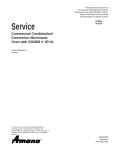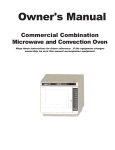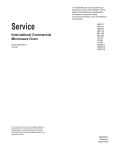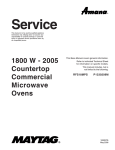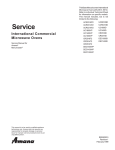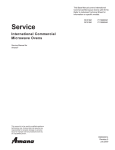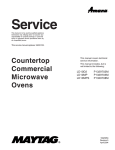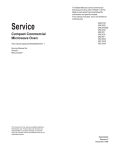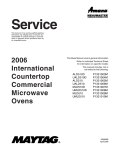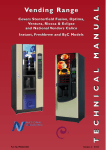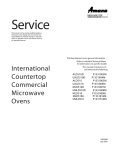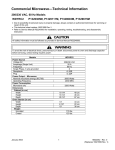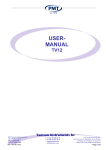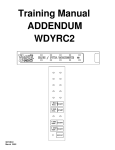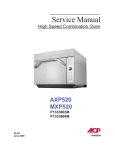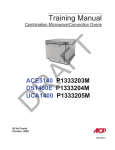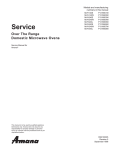Download Amana Commercial Combination Oven Service manual
Transcript
This Base Manual covers all International Commerical Combination/Convection Microwave Ovens with 230 V, 50 Hz. Refer to individual Technical Sheet for information on specific models. Service ACE530 UACE530 DS30E UDS30E UCA2000NT International Commercial Combination/Convection Microwave Oven with 230 V, 50 Hz Service Manual for Amana® This manual is to be used by qualified appliance technicians only. Amana does not assume any responsibility for property damage or personal injury for improper service procedures done by an unqualified person. ® RS5320016 Revision 0 December 2001 Important Information Pride and workmanship go into every product to provide our customers with quality products. It is possible, however, that during its lifetime a product may require service. Products should be serviced only by a qualified service technician who is familiar with the safety procedures required in the repair and who is equipped with the proper tools, parts, testing instruments and the appropriate service manual. REVIEW ALL SERVICE INFORMATION IN THE APPROPRIATE SERVICE MANUAL BEFORE BEGINNING REPAIRS. Important Notices for Consumers and Servicers ! WARNING To avoid risk of serious injury or death, repairs should not be attempted by an unauthorized personal, dangerous conditions (such as exposure to electrical shock) may result. ! CAUTION Amana will not be responsible for any injury or property damage from improper service procedures. If preforming service on your own product, assume responsibility for any personal injury or property damage which may result. To locate an authorized servicer, please consult your telephone book or the dealer from whom you purchased this product. For further assistance, please contact: CONSUMER AFFAIRS DEPT. AMANA AMANA, IOWA 52204 OR CALL 1-319-622-5511 and ask for Consumer Affairs If outside the United States contact: AMANA ATTN: CONSUMER AFFAIRS DEPT AMANA, IOWA 52204, USA Telephone: (319) 622-5511 Facsimile: (319) 622-2180 TELEX: 4330076 AMANA CABLE: "AMANA", AMANA, IOWA, USA Recognize Safety Symbols, Words, and Labels ! DANGER - DANGER Immediate hazards which WILL result in severe personal injury or death. ! WARNING WARNING - Hazards or unsafe practices which COULD result in severe personal injury or death. ! CAUTION CAUTION - Hazards or unsafe practices which COULD result in minor personal injury or product or property damage. RS5320016 Rev. 0 2 Table of Contents Important Information ................................................. 2 Important Product Information .................................... 4 Important Safety Information ...................................... 5 Product Information Strirrer Blade ...................................................... 8 Blower/Fan Assembly ......................................... 8 Stirrer Cover ....................................................... 8 Door Interlock and Monitoring Switch.................... 8 Transformer High Voltage ..................................... 8 High Voltage Capacitor ........................................ 8 High Voltage Diode (Rectifier) .............................. 8 Magnetron .......................................................... 8 Thermal Protectors ............................................. 8 Touch Panels ..................................................... 8 Triacs ................................................................ 8 RTD (Resistive Thermal Device) ........................... 8 Heating Elements ............................................... 8 Component Testing Procedures ................................. 9 Test Modes Microwave Power Test ....................................... 13 Temperature Chart ............................................ 13 Convection Temperature Test ............................. 14 Convection Temperature Calibration .................... 14 Microwave Leakage Test .......................................... 15 Equipment ....................................................... 15 Procedure For Measuring Radiation Leakage ...... 15 Measurement With the Outer Panel Removed ..... 15 Measurement With a Fully Assembled Oven ....... 15 Record Keeping and Notification After Measurement .......................... 15 Display Diagnostics Error Codes ...................................................... 16 Service Test ........................................................... 17 Troubleshooting Power up .......................................................... 19 Preheat/Convection Condition ............................ 19 Microwave Condition ......................................... 20 Disassembly Door Handle ..................................................... 21 Outer Door ....................................................... 21 Inner Door Assembly ......................................... 21 Hinge ............................................................... 21 Outer Case ...................................................... 22 Back Panel ...................................................... 22 Stirrer Cover ..................................................... 22 RTD (Resistance Thermal Device) ...................... 22 Top Touch Panel Assembly ................................ 22 Side Touch Panel Assembly .............................. 23 High Voltage Circuit Board ................................. 23 Interlock Switch Module .................................... 23 Adjustment ................................................ 23 Display Module ................................................. 24 Magnetron ........................................................ 24 Magnetron, Control, and Fan Thermal Cutout (TCO) ................................. 24 Triacs .............................................................. 24 Microwave Blower Wheel and Motor ................... 24 Fan Blade ........................................................ 25 Transformer ...................................................... 25 Capacitor ......................................................... 25 Heater Box ....................................................... 25 Heating Elements ............................................. 25 Convection Fan and Motor ................................. 25 Fuse ................................................................ 25 Power Cord ...................................................... 26 Light Socket ..................................................... 26 Line Filter ......................................................... 26 Replacing Oven Light Bulb ................................. 26 Component Location ............................................... 27 Appendix A Owner's Manual ............................................... A-2 Amana • 2800 220thTrail • PO Box 8901 • Amana, Iowa • 52204 • Printed in the U.S.A. 3 RS5320016 Rev. 0 Important Product Information ! ! WARNING To avoid risk of electrical shock, personal injury or death; verify earthing instructions are followed. Precautions to be observed before and during servicing to avoid possible exposure to excessive microwave energy, or electrical shock disconnect power to oven. Earthing Instructions ! Do not operate or allow oven to be operated with door open. WARNING Do not remove earthing prong when installing earthed appliance in a home or business that does not have three wire earthing receptacle, under no condition is earthing prong to be cut off or removed. It is the personal responsibility of the consumer to contact a qualified electrician and have properly earthed three prong wall receptacle installed in accordance with appropriate electrical codes Make the following safety checks on all ovens to be serviced before activating the magnetron or other microwave source, and make repairs as necessary: • Interlock operation • Proper door closing • Seal and sealing surfaces (arcing, wear, and other damage) • Damage to or loosening of hinges and latches • Evidence of dropping or abuse Should a two prong adapter plug be required temporarily it is the personal responsibility of the consumer to have it replaced with properly earthed three prong receptacle or the two prong adapter properly earthed by a qualified electrician in accordance with appropriate electrical codes. Before turning on microwave power for any service test or inspection within the microwave generating compartments, check the magnetron, waveguide or transmission line, and cavity for proper alignment, integrity, and connections. Any failed or misadjusted components in the interlock, monitor, door seal, and microwave generation and transmission systems shall be repaired, replaced or adjusted by procedures described in this manual before oven is released to the consumer. Servicing of Earthed Products The standard accepted color coding for earthing wires is GREEN or GREEN WITH YELLOW STRIPE. These earth leads are NOT to be used as current carrying conductors. It is extremely important that the technician replace any and all earths prior to completion of the service call. Under no condition should earth wire be left off causing a potential hazard to technicians and consumer. Check microwave leakage to verify compliance with the federal performance standard should be performed on each oven prior to release to the consumer. WIRING Good service practice is to never route wiring over terminals and/or sharp edges. This applies to any wiring without regard to the circuit voltage. Wire insulation material and thickness is designed and regulated for electrical spacing purpose only, but cannot always be relied upon because of possible cuts and/or abrasions, which can occur during servicing. RS5320016 Rev. 0 WARNING 4 Important Safety Information 5 RS5320016 Rev. 0 Important Safety Information RS5320016 Rev. 0 6 Important Safety Information 7 RS5320016 Rev. 0 Product Information Stirrer Blade Transformer High Voltage Distributes microwave energy throughout the cavity. High voltage transformer is used in this unit, which supplies high voltage A.C. for operation of the magnetron tube. Blower/Fan Assembly Circulates cooling air throughout the convection or microwave oven compartment and cavity. High Voltage Capacitor Doubles the A.C. output voltage from the high voltage transformer. Stirrer Cover Covers and protects the stirrer blade assembly. High Voltage Diode (Rectifier) Is connected at the output side of the high voltage capacitor. It changes voltage from A.C. to D.C. It passes current in one direction and blocks it in the other. Also called a rectifier. Door Interlock and Monitoring Switch NOTE: When the line fuse is blown the Interlock Switch Assembly must be replaced. Interlock switch (assembly) mounts behind oven cavity front bulkhead. It is actuated by door hook and guide attached to the door. Magnetron With filament voltage and high D.C. voltage from the output of the H.V. capacitor, diode junction the magnetron will put out an electomagnetic radio frequency of 2450 MHz to heat the food load in the oven. Monitoring switch (contacts 7 and 8) is actuated by the door guide. The secondary interlock switch (contacts 2 and 3) and primary interlock switch (contacts 4 and 5) are actuated by the door hook. Thermal Protectors The secondary interlock switch is in series with the interlock monitoring switch in the monitor circuit. At a predetermined temperature the thermal cut-outs will open or close. The oven will indicate an error code in the display, initiate cooling fan operation, or prevent the generation of microwave energy. If a malfunction occurs in the secondary interlock when door opens, current will flow through the monitor switch causing the oven fuse to open. • Magnetron thermal cut-out is mounted directly on the body of the magnetron • Fan thermal cut-out is mounted directly on the exhaust duct • Control thermal cut-out is mounted directly on the heater box If a faulty door interlock switch has allowed current through the monitor switch, the switch assembly must be replaced (see interlock switch testing) before replacing fuse. ! DANGER Touch Panels To avoid severe personal injury or death avoid contacting any high voltage parts. The capacitors are at high voltage (4000 volt) potential and it is extremely important that they be grounded before handling. Allows consumer operation and programming of oven. Triacs Triacs are controlled by high voltage circuit boards. Triacs control one side of the power line going to the high voltage power transformer and heating elements. • Microwave triacs, heating elements A, and B triacs are mounted inside oven chassis behind oven cavity front bulkhead RTD (Resistance Thermal Device) Senses temperature inside oven cavity. Heating Elements Heating elements are used to produce convection heat. RS5320016 Rev. 0 8 Component Testing Procedures ! WARNING To avoid risk of electrical shock, personal injury or death; disconnect power to oven and discharge capacitor before servicing, unless testing requires power. Illustration Component Thermal cutout Test Disconnect all wires from TCO. Measure resistance across terminals. Control TCO............................................. Fan TCO.................................................. Magnetron TCO ....................................... Diode Discharge Capacitor Remove diode lead from capacitor and connect ohmmeter. Reverse leads for second test. Triac Measure resistance from: MT1 to MT2 .......................................... MT1 to Gate.......................................... MT2 MT1 Disconnect wires to triac. GA TE Triac 1 (top) is for front element Triac 2 (middle) is for rear element Triac 3 (bottom) is for microwave Capacitor Snubber assembly Magnetron Microwave blower motor MT2 to Gate.......................................... All terminals to ground .......................... Measure voltage from: MT1 to Gate Results Open at 300°F (149°C) and closed at 257°F (125°C) Open at 125°F (52°C) and closed at 160°F (71°C ) Open at 235°F (113°C) and closed at 150°F (66°C) Infinite resistance should be measured in one direction and 50KΩ or more in the opposite direction. NOTE: Ohmmeter must contain a battery of 6 volts minimum. Caution - Do not operate oven with wire to terminal MT2 removed. Infinite Approximately 15 Ω, then reverse meter leads 30 Ω Infinite Infinite 0.8 VAC when energized If no voltage, check H.V. board and wiring. Discharge Capacitor Remove wires from capacitor terminals and connect ohmmeter, set on highest resistance scale to terminals. Between Terminals: Meter should momentarily deflect towards zero then return to over 5 MΩ. If no deflection occurs, or if continuous deflection occurs, replace capacitor. Also check between each terminal and capacitor case............................................. Disconnect wires to snubber. Terminal to Case: Infinite resistance Measure resistance across terminals .......... Infinite Discharge Capacitor Between Terminals: Less than 1 Ω Remove wires from magnetron and connect ohmmeter to terminals. Also check between each terminal and ground. Each terminal to ground measures Infinite resistance. Note: This test is not conclusive. If oven does not heat and all other components test good replace the magnetron and retest. Remove all wires from motor. Measure resistance across coil ................... 9 Approximately 30 Ω RS5320016 Rev. 0 Component Testing Procedures ! WARNING To avoid risk of electrical shock, personal injury or death; disconnect power to oven and discharge capacitor before servicing, unless testing requires power. Illustration Component Transformer 6 COM 5 4 Measure resistance from: 230 to COM ................................................ 220 to COM ................................................ 230 to Ground............................................. 220 to Ground............................................. Terminal 5 to 6............................................ Terminal 4 to Ground.................................. 230 220 Interlock switch Door Closed 7 2 3 Secondary 4 5 Primary 8 Monitor 7 8 2 4 3 5 Convection blower motor A Heating element assembly Resistance thermal device (RTD) IN Brown Blue Results < 1.5 Ω < 1.5 Ω Infinite Infinite <1Ω Approximately 70 Ω Disconnect wires to switch. With door open measure resistance from: Terminal 2 to 3........................................... Terminal 4 to 5........................................... Terminal 7 to 8........................................... Infinite Infinite Indicates continuity With door closed measure resistance from: Terminal 2 to 3........................................... Terminal 4 to 5........................................... Terminal 7 to 8........................................... Indicates continuity Indicates continuity Infinite Remove wires from motor. Measure resistance across terminals A and B ....................................... B Blue Test Discharge Capacitor Remove all wires from terminals. Approximately 20 Ω Disconnect wires from terminals. Measure resistance across heating element. Front element 1200 W ...................... Rear element 1500 W ...................... Indicates continuity Front element Rear element Temperature 48 Ω 48 Ω Resistance 1100 W ...................... 1100 W ...................... 44 Ω 35 Ω 0°C (32°F)................................................... 1000 Ω 177°C (350°F)............................................. 1654 Ω Lamp receptacle Test continuity of receptacle terminals. Indicates continuity with bulb screwed in. Line filter Disconnect wire from terminals. Measure resistance of the following terminals: OUT Blue to Blue............................................ <1Ω Brown Brown to Brown ...................................... <1Ω RS5320016 Rev. 0 10 Component Testing Procedures ! WARNING To avoid risk of electrical shock, personal injury or death; disconnect power to oven and discharge capacitor before servicing, unless testing requires power. Illustration Test Continuity is indicated as 100 Ω and below. Top touch panel Continuity is indicated as 100 Ω and below. High voltage board to display module harness Test continuity of wires. 1 Component Side touch panel Pad 1 2 3 4 5 6 7 8 9 0 Start Stop/Reset Pad Preheat Time Entry Temp Entry Power Level Stage Program Save Hidden Pad Results Trace 3&5 3&6 3&7 3&8 3&9 4&5 4&6 4&7 4&8 4&9 5&6 6&9 Trace 3&4 5&7 7&8 5&8 5&9 6&7 8&9 Measurement Continuity Continuity Continuity Continuity Continuity Continuity Continuity Continuity Continuity Continuity Continuity Continuity Measurement Continuity Continuity Continuity Continuity Continuity Continuity Continuity 1 Wire harness Indicates continuity Display board Pin 1 Interlock Connector J1 Side Touch Panel Connector Pin 1 J6 Pin 1 J4 Pin 1 J5 Top Touch Panel Connector H.V. board Connector 3.5 VAC should be indicated whenever the oven is plugged into a power supply. If voltage is present and no display is indicated, replace display board. If no voltage is present, check wire harness connections and H.V. board. 11 RS5320016 Rev. 0 Component Testing Procedures ! WARNING To avoid risk of electrical shock, personal injury or death; disconnect power to oven and discharge capacitor before servicing, unless testing requires power. H.V. board Clip Pin 1 E6 J4 J7 E7 Clip Pin 1 Clip Pin 1 J8 J6 Pin 1 Pin 1 J5 Pin 50 J3 Pin 28 Pin 1 E3 E5 Clip E4 J2 E2 J1 Pin 1 Clip Pin 1 E1 Clip Clip In straight convection mode, both elements operate simultaneously. In combination mode, the rear element will operate simultaneously with either the microwave or front element. Function Test Set-Up Meter Probe Placement Results Setting Input to H.V. board At H.V. board Volts J1 pin 1 (Black wire) Line voltage & J1 pin 2 (Red wire) Output to display Disconnect Volts J5 pin 28 & - 24 VDC board J5 connector J5 pin 50 NOTE: For the following test, place oven in Service Test Mode (see page 27). Relay Function K1 Cooling fan K2 Convection motor Cavity light K3 K4 K7 K9 Heater A (front) Microwave Heater B (rear) RS5320016 Rev. 0 Test Set-Up Disconnect J2 connector Disconnect J2 connector Disconnect J2 connector Disconnect J3 connector Disconnect J4 connector Disconnect J4 connector Meter Setting Ohms Ohms Ohms Ohms Ohms Ohms Probe Placement J1 pin 1 (Black wire) & J2 pin 4 J1 pin 1 (Black wire) & J2 pin 3 J2 pin 1 & J2 pin 2 E4 & J3 pin 3 J4 pin 4 & J4 pin 5 E6 & J4 pin 1 12 Results Test mode 5 off - no continuity Test mode 5 on - < 1 Ω Test mode 4 off - no continuity Test mode 4 on - < 1 Ω Test mode 6 off - no continuity Test mode 6 on - < 1 Ω Test mode 2 off - no continuity Test mode 2 on - < 1 Ω Test mode 3 off - no continuity Test mode 3 on - < 1 Ω Test mode 1 off - no continuity Test mode 1 on - < 1 Ω Test Modes Microwave Power Test (TRADITIONAL TEST METHOD) Test Equipment Needed: • Amana power test kit R0157397, Fahrenheit or • Menumaster power test kit M95D5, Centigrade. 1. Place one rack in the oven using lowest rack position. 2. Fill the plastic container to the bottom of the 1000 ml. lines with cool tap water. 3. Using the thermometer; Fahrenheit or Centigrade, stir the water, measure and record the water temperature. IMPORTANT: Initial water temperature should be approximately 20°C (60°F). 4. Place the container on the center of the oven rack and heat the water for 62 seconds. a. Close the door. b. Press Hidden Pad, 1, 3, 5, 7, 9. c. Press 3 to activate microwave mode. d. Display counts up to 62 seconds, and unit shuts off. e. Open the door. 5. Stir the water, measure and record the temperature of the water after heating time is completed. 6. Subtract the starting water temperature (Step 3) from the ending water temperature (Step 5) to obtain the temperature rise. 7. Refer to the Temperature Chart. NOTES: • The IEC-705 test method requires precision measurements and equipment. It is not practical to perform the IEC test in the field. To convert the traditional power test results to the approximate IEC-705 rating, take the traditional power test results and add 100 watts per magnetron for the unit being tested. Example: 900 watts output using the traditional power test for model ACE530 + 100 watts (100 watts X each magnetron) 1000 Approximate IEC-705 results • Always perform power test three times for accuracy, changing the water after each test is performed. • Variation or errors in the test procedure will cause a variance in the temperature rise. Additional power tests should be made if temperature rise appears marginal. • Low line voltage will cause lower temperature rise. Temperature Chart ONE MINUTE, TWO SECONDS run time chart for units less than 1550 watts cooking power. ∆T (°F) Cooking Power Output ∆T Cooking ∆T (°F) Power Output (°C) Cooking Power Output ∆T Cooking (°C) Power Output 12 464 20 775 7 490 12 840 13 504 21 814 8 560 13 910 14 542 22 852 9 630 14 980 15 581 23 891 10 700 15 1050 16 620 24 930 11 770 17 659 25 969 18 697 26 1007 19 736 13 RS5320016 Rev. 0 Test Modes Convection Temperature Test Convection Temperature Calibration NOTE: It is absolutely necessary to own and use a thermocouple type oven tester to accurately measure oven temperature. No other type of thermometer can take its place. NOTE: It is normal for the average oven temperature to vary from the oven setting by as much as 25°F (14°C). Difference will not effect cooking since recipes are written with this difference in mind. NOTE: Before testing an oven to check calibration, inspect the RTD for proper mounting. Calibration 1. Place one wire rack in center position. Remove any other racks and utensils. NOTE: Door must be closed. 2. Clip thermocouple to the center rack and run lead outside oven door, or wrap thermocouple around rack and have tip of thermocouple extend upward towards top of cavity approximately 1". 2. Press pads 1,3,5,7, 9. 1. Press HIDDEN PAD. 3. Press "0" pad. ITEM 3. Press PREHEAT ON/OFF pad. 4. Press PROGRAM SAVE pad. C M 5. Press TEMP pad. STG QTY 1 2 3 4 LMT POWER PREHEAT NOT READY STANDBY COOK LEVEL 6. Enter 230°C (450°F). NOTE: Display will show the current offset setting. 7. Allow oven to cycle one time. 4. Press the "0" pad to change the offset. 8. Record high and low peaks from next two cycles. NOTE: Display does not indicate if heating elements are on or off. Fahrenheit NOTE: Offset temperature range is +40°F to -40°F and advances in 2 and 3° increments. Fahrenheit Example: LOW HIGH Cycle 1 440°F 460°F Cycle 2 439°F 461°F 879°F + Celsius Example: LOW HIGH Cycle 1 230°C 240°C Cycle 2 230°C 240°C + NOTE: Offset temperature range is +22°C to -22°C and advances in 1 and 2° increments. 5. Press STOP/RESET pad to save offset changes. 921°F = 1800°F 1800°F / 4 = 450°F average temperature 450°C Celsius NOTE: Retest the oven after any offset changes are made. • • • • Fahrenheit Example: Oven temperature is set for 450°F. Average of temperature test is 475°F. Offset setting must be reduced by 25°F. If offset is shown as 10°, press the "0" pad until -15 is shown in the display (10 – 25 = -15). • • • • Celsius Example: Oven temperature is set for 230°C. Average of temperature test is 240°C. Offset setting must be reduced by 10°C. If offset is shown as 5°, press the "0" pad until -5 is shown in the display (5 – 10= -5). 480°C = 930°C 930°C / 4 = 230°C average temperature If the average temperature is too high or too low the oven temperature offset needs to be calibrated. RS5320016 Rev. 0 14 Microwave Leakage Test ! Measurement With the Outer Case Removed WARNING ! Check for radiation leakage after servicing. Should the leakage be more than 4mW/cm2 inform Amana immediately. After repairing or replacing any radiation safety device, keep a written record for future reference, as required by D.H.H.S. and HEW regulations. This requirement must be strictly observed. In addition, the leakage reading must be recorded on the service repair ticket while at the customer’s location. DANGER To avoid risk of personal injury or death avoid contacting any high voltage components. Whenever you replace the magnetron, measure for radiation leakage before the outer case is installed and after all necessary components are replaced or adjusted. Special care should be taken in measuring around the magnetron. Equipment Measurement With a Fully Assembled Oven • Electromagnetic radiation monitor • 600 cc glass beaker After all components, including the outer panel are fully assembled, measure for radiation leakage around the door periphery, the door viewing window, the exhaust opening, and air inlet openings. Procedure For Measuring Radiation Leakage Note before measuring - Record Keeping and Notification After Measurement • Do not exceed meter full scale deflection. Leak monitor should initially be set to the highest scale. • To prevent false readings the test probe should be held by the grip portion of the handle only. • The scan speed is equal to one inch per antenna revolution or one inch per second if antenna speed is unknown. • Areas to be checked are all door seal areas and any venting parts. • Leakage with the outer panel removed, 4mW/cm2 or less. • Leakage for fully assembled oven with door normally closed, 4mW/cm2 or less. • Leakage for a fully assembly oven (before the latch switch (primary) is interrupted) while pulling the door, 4mW/cm2 or less. 1. After any adjustment or repair to a microwave oven, a leakage reading must be taken. Record this leakage reading on the repair ticket even if it is zero. 2. A copy of the repair ticket and the microwave leakage reading should be kept by the repair facility. 1. Open the oven door and verify that there is only one rack in place on the bottom rack hooks. 2 . Pour 275 ± 15 cc (9 oz ± 1/2 oz) of 20 ± 5°C. (68± 9°F.) water in a glass beaker which is graduated to 600 cc and place the beaker in the center of rack. 3. Set the radiation monitor to 2450 MHz and use it following the manufacturer’s recommended test procedure to assure correct results. 4. While measuring the leakage, always use the two inch (5 cm) spacer supplied with the probe. 5. Press the start pad or turn on the timer and with the magnetron oscillating, measure the leakage by holding the probe perpendicular to the surface being measured. 15 RS5320016 Rev. 0 Display Diagnostics ! CAUTION All repairs as described in this troubleshooting section are to be performed only after the caution procedures one through eight listed below have been followed. 1. Check grounding before checking for possible causes. 2. Be careful of the high voltage circuit. 3. Discharge high voltage capacitor. 4. When checking the continuity of the switches or the high voltage transformer, disconnect one lead wire from these parts and then check continuity with the AC plug removed. To do otherwise may result in a false reading or damage to your meter. 5. Do not touch any parts of the circuitry on the P.C. Board circuit since static electric discharge may damage this control panel. Always touch yourself to ground while working on this panel to discharge any static charge in your body. 6. 208/230 VAC is present in the high voltage circuit board, power relay and primary circuit of low voltage transformer. 7. When troubleshooting, be cautious of possible electrical hazard. 8. When testing convection operation, convection fan may start at any time or if oven is hot. Error Codes During operation, the display may show the following service codes: NOTE: Before scheduling service for any error codes, instruct customer to unplug oven for 1 minute, reconnect power, and retest. If unit operates properly, no service call is required. Display Err1 Description Checksum Error Err2 Hardware Problem Err3 Hardware Problem Err4 Hardware Problem Err5 Defective Touch Panel Err6 RAM Error Err7 Error with RTD circuit If power level shows 0Uncalibrated .................................. 1Shorted RTD circuit....................... 2Open RTD circuit ........................... HOT Door RS5320016 Door Interlock Primary Switch Rev. 0 Corrective Action See note above. Replace H.V. board. See note above. Verify wiring at H.V. board. If wiring is good, replace H.V. board. May be a failed Touch Panel. Verify before replacing. See note above. Verify wiring at H.V. board. If wiring is good, replace H.V. board. May be a failed Touch Panel. Verify before replacing. See note above. Check green jumper at J8 connector on H.V. board. If jumper is good, replace H.V. board. See note above. If Touch Panel is pressed for more than 30 seconds, this error code will appear. Replace touch panel. See note above. Replace H.V. board. See note above. Replace H.V. board. Check RTD and wiring to H.V. board. Check RTD and wiring to H.V. board. See note above. Open TCO. Convection motor inoperative. Restricted air filter. H.V. board inoperative. Broken or loose wire. See note above. Verify latch mechanism moves freely on door. Verify J1 connector on display board is properly seated. Test interlock switch assembly and perform door adjustment if necessary. Replace interlock switch assembly if failed. 16 Service Test NOTE: Unit must be in STANDBY mode. To Enter Service Mode, oven door must be closed. NOTE: Pads will not beep when pressed. ITEM Press Hidden Pad Hidden Pad PREHEAT ON / OFF Then 1 3 Press 5 7 9 C M Display 0 = Deactivated 1 = Activated ITEM C M LMT POWER PREHEAT NOT READY STANDBY COOK LEVEL Displays actual Amperage 1 Toggles Element B (Rear) ON/OFF. ITEM C M STG QTY 1 2 3 4 LMT 1 2 3 4 LMT POWER PREHEAT NOT READY STANDBY COOK LEVEL Component Evaluation STG QTY 1 2 3 4 STG QTY POWER PREHEAT NOT READY STANDBY COOK LEVEL Indicates Service Mode If no Amperage, check: Heating element Triac 2 (middle) H.V. board (relay K9 and triac 2 drive voltage) Wiring Timer counts up to 99 seconds. Displays actual Amperage 2 Toggles Element A (Front) ON/OFF. ITEM C M STG QTY 1 2 3 4 LMT POWER PREHEAT NOT READY STANDBY COOK LEVEL Timer counts up to 99 seconds. Displays actual Amperage 3 Toggles Microwave ON/OFF. If no Amperage, check: Heating element Triac 1 (top) H.V. board (relay K4 and triac 1 drive voltage) Wiring ITEM C M STG QTY 1 2 3 4 LMT POWER PREHEAT NOT READY STANDBY COOK LEVEL Timer counts up to 62 seconds and unit shuts off. If no Amperage, check for line voltage at H.V. transformer primary winding. If no voltage, check: Interlock switch (secondary) Magnetron TCO Triac 3 (bottom) H.V. board (relay K7 and triac 3 drive voltage) Wiring If voltage is present, check H.V. components and wiring. 4 Toggles Convection Fan ON/OFF. ITEM C M STG QTY 1 2 3 4 LMT POWER PREHEAT NOT READY 17 STANDBY COOK LEVEL If no fan operation, check: Convection fan motor and wheel H.V. board (relay K2) Wiring RS5320016 Rev. 0 Service Test Press Display 5 Toggles Cooling Fan ON/OFF. 6 Toggles Oven Light ON/OFF. 7 Displays # of Magnetron Hours. 8 Displays # of Door Cycles with a 1 to 1 ratio rounded to the nearest ten 9 Clears Hours and Cycles (press START to activate) (Resets to 0). 0 Displays current Temperature OFFSET. ITEM C M RS5320016 Rev. 0 STG QTY 1 2 3 4 LMT ITEM STG QTY C M LMT 1 2 3 4 ITEM STG QTY C M LMT 1 2 3 4 ITEM STG QTY C M LMT 1 2 3 4 ITEM STG QTY C M LMT 1 2 3 4 ITEM STG QTY C M LMT 1 2 3 4 POWER PREHEAT NOT READY STANDBY PREHEAT NOT READY STANDBY COOK LEVEL POWER PREHEAT NOT READY STANDBY COOK LEVEL POWER PREHEAT NOT READY STANDBY COOK LEVEL POWER PREHEAT NOT READY STANDBY COOK LEVEL POWER PREHEAT NOT READY STOP RESET 18 STANDBY If no fan operation, check: Cooling fan motor and wheel H.V. board (relay K1) Wiring COOK LEVEL POWER Display current oven Temperature as sensed by RTD. TEMP To Exit Service Mode Press Component Evaluation COOK LEVEL If no light operation, check: Oven light H.V. board (relay K3) Wiring Troubleshooting Power Up Plug oven into power source. Proceed to DISPLAY DIAGNOSTICS. Error Code Appears ITEM C M STG QTY 1 2 3 4 POWER NO LMT PREHEAT NOT READY STANDBY COOK LEVEL 1. 2. 3. 4. 5. 6. POWER UP CONDITION NORMAL No line voltage. Inoperative power cord. Inoperative fuse. Inoperative display board. Inoperative H.V. board. Broken or loose wire connection. Preheat/Convection Condition Press PREHEAT ON / OFF FLASHES for 1 minute. ITEM C M STG QTY 1 2 3 4 LMT POWER PREHEAT NOT READY STANDBY 1. 2. 3. 4. NO COOK LEVEL Inoperative top touch panel. Inoperative interlock switch. Inoperative H.V. board. Broken or loose wire connection. FLASHES until unit reaches PREHEAT temperature. Blower operating cavity light on. NO 1. 2. 3. 4. 5. Error Code READY CONDITION NORMAL ITEM C M STG QTY 1 2 3 4 LMT Proceed to DISPLAY DIAGNOSTICS. POWER PREHEAT NOT READY STANDBY Binding or inoperative blower motor. Inoperative cavity light. Inoperative H.V. board. Inoperative display board. Broken or loose wire connection. 1. 2. 3. 4. COOK LEVEL 19 Inoperative heating element. Inoperative triac. Inoperative H.V. board. Broken or loose wire connection. RS5320016 Rev. 0 Troubleshooting Microwave Condition Open door, place cup of water in oven. Close oven door. Press PREHEAT ON / OFF C M ITEM C M STG QTY 1 2 3 4 LMT POWER PREHEAT NOT READY STANDBY STG QTY 1 2 3 4 LMT TEMP 1. 2. 3. 4. NO COOK LEVEL enter desired microwave power level. Inoperative top touch panel. Inoperative side touch panel. Inoperative H.V. board. Broken or loose wire connection. POWER PREHEAT NOT READY STANDBY COOK LEVEL Heats Slowly 1. Inoperative or misadjusted interlock switch module. 2. Inoperative magnetron. 3. Inoperative thermal cutout. 4. Broken or loose wire connection. End of cycle tone sounds. Open door and remove water. Is water heated? NO 1. YES 2. 3. 4. 5. 6. 7. 8. MICROWAVE CONDITION OPERATING PROPERLY RS5320016 POWER LEVEL enter 70 C START Press ITEM TIME enter desired time Rev. 0 20 No Heat Inoperative or misadjusted interlock switch module. Inoperative thermal cutout. Inoperative triac. Inoperative diode. Inoperative capacitor. Inoperative H.V. transformer. Inoperative magnetron. Broken or loose wire connection. Disassembly ! WARNING To avoid the risk of electrical shock, personal injury or death; disconnect power to oven and discharge capacitors before following any disassembly procedure. Door Handle Inner Door Assembly Remove door handle by removing plactic plugs to gain access to set screws. Loosen set screws using a (3/32 inch allen screws), one located to the left of the door handle and one located on the bottom of the door handle. 1. Remove door handle. Tighten first 2. Remove outer door. 3. Remove insulation pads from inner door assembly. 4. Remove screws securing inner door assembly to hinge. 5. Reassemble inner door assembly in reverse order. Pointed tip Hinge 1. Remove outer case. 2. Remove door handle. Plastic plugs Flat tip 3. Remove outer door assembly. 4. Remove hinge mounting screws from hinge (five on front, four on side). NOTE: When replacing door handle, tighten side set screw first. NOTE: Discard foam gasket on side of hinge. NOTE: If set screws are removed, the set screw with the flat end must be used in the bottom of the door handle. 5. When reinstalling hinge mounting screws, keep the side screws loose and the front screws tight, close door, press door against oven on the hinge side and tighten side hinge mounting screws in the sequence shown below. Outer Door 1 1. Remove door handle. 2. Remove plastic plugs covering screws with a thin flat blade screwdriver. 3 3. Remove crows foot screws using crows foot driver (92113P01), securing outer door to inner door assembly. 4 4. Remove outer door from inner door assembly. 2 5. Reassemble outer door in reverse order. Inner Door Assembly Outer Insulation Inner Insulation Outer Door 21 RS5320016 Rev. 0 Disassembly ! WARNING To avoid the risk of electrical shock, personal injury or death; disconnect power to oven and discharge capacitors before following any disassembly procedure. Outer Case 1. Remove screws securing outer case to chassis, see illustration below. 2. Slide outer case back and lift off. 3. Reassemble outer case in reverse order. Back Panel 1. Remove outer case. 2. Remove screws securing back panel. 3. Reassemble back panel in reverse order. Stirrer Shaft Stirrer Blade Stirrer Insert Stirrer Cover Back Panel Stirrer Cover Mounting Clip Outer Case Mounting Screw RTD (Resistance Thermal Device) 1. See “Component Location” Figure 4, for location. Stirrer Cover 2. Remove outer case. 1. See “Component Location” Figure 4, for location. 3. Disconnect RTD harness connector. 2. Unplug oven before removing stirrer cover to access stirrer assembly. 4. Remove mounting screw located inside oven. 5. Lift RTD from top of the oven. 3. Loosen screw securing stirrer cover mounting clip and rotate clip to the side. 6. Reassemble RTD in reverse order. 4. Slowly lower front of stirrer cover, then pull gently towards front of unit to release cover. Top Touch Panel Assembly 1. See “Component Location” Figure 1, for location. 5. Replace stirrer cover by fitting stirrer blade on stirrer insert. Place back of stirrer cover into place, align stirrer insert onto stirrer shaft. Lift front of cover into position, rotate mounting clip into position, tighten screw. ! 2. Remove outer case. 3. Disconnect all wire connectors at display board. 4. Remove screws securing top touch panel to unit. 5. Remove screws securing display board to top touch panel assembly. CAUTION 6. Reassemble touch panel in reverse order. If mounting clip is loose arcing will occur. RS5320016 Rev. 0 22 Disassembly ! WARNING To avoid the risk of electrical shock, personal injury or death; disconnect power to oven and discharge capacitors before following any disassembly procedure. Side Touch Panel Assembly Interlock Switch Module 1. See “Component Location” Figure 1, for location. 1. See “Component Location” Figure 2, for location. 2. Remove outer case. 2. Remove outer case. 3. Remove ribbon cable from display board. 3. Disconnect wiring from interlock switch assembly. 4. Remove mounting screws securing side touch panel to unit. 4. Remove mounting screws securing interlock switch. 5. Reassemble touch panel in reverse order. 5. When replacing assembly, all wires must be connected before operating oven. High Voltage Circuit Board NOTE: When the line fuse is blown interlock switch module must be replaced. 1. See “Component Location“ Figure 2, for location. 2. Remove outer case. 3. Unplug connectors. 4. Disconnect wires from terminal locations on H.V. board. 5. Release mounting clips and remove board. 7 6. Reassemble high voltage board in reverse order. Clip J4 Pin 1 E6 Pin 1 Clip J7 E7 Pin 1 8 Clip J8 2 J6 Pin 1 4 3 5 Pin 1 J5 Pin 50 J3 Pin 28 Pin 1 E3 E5 Clip E4 J2 Pin 1 Clip Pin 1 Adjustment 1. To adjust interlock switch assembly, close door. E1 E2 J1 Clip Clip 2. Loosen bottom and top screw on the interlock switch assembly, allowing switch assembly to move in or out. NOTE: When reassembling, verify cable connection with illustration of cable locations. 3. With door closed, push forward on interlock assembly to engage door latch. Then pull back on interlock assembly until door is "snug" against front oven cavity and tighten bottom screw first, then top screw. 4. Door will remain latched when proper adjustment is made. NOTE: If door is not properly adjusted display will indicate DOOR when the door is closed. 23 RS5320016 Rev. 0 Disassembly ! WARNING To avoid the risk of electrical shock, personal injury or death; disconnect power to oven and discharge capacitors before following any disassembly procedure. Display Module Triacs 1. See “Component Location” Figure 1, for location. 1. See “Component Location” Figure 1, for location. 2. Remove outer case. 2. Remove outer case and back panel. 3. Remove top touch panel, see Top Touch Panel Assembly procedure. 3. Remove wires from terminals of selected triac. 4. Reassemble display module in reverse order. 5. Reassemble triac in reverse order. Magnetron Microwave Blower Wheel and Motor 1. See “Component Location” Figure 3, for location. 1. Remove outer case and back panel. 2. Remove outer case. 2. Remove wiring from blower motor terminals. 3. Remove screws securing magnetron inlet cover and remove cover. 3. Remove screws securing blower assembly to bracket. 4. Remove screws securing waveguide duct. 4. Remove assembly from oven. 5. Remove wires from magnetron. 5. Loosen allen set screw securing blower wheel to motor shaft. 4. Remove screws securing triac to chassis. 6. Remove allen screws securing magnetron thermal cutout bracket to magnetron. 6. Remove blower wheel. 7. Remove magnetron mounting nuts and remove front magnetron cover bracket. 7. Remove screws securing motor to scroll. 8. Reassemble blower wheel and motor in reverse order. 8. Remove magnetron. 9. When replacing magnetron, verify wire mesh gasket is reinstalled properly. NOTE: When reinstalling blower wheel, push blower wheel on shaft, tighten, and rotate to insure clearance between blower wheel, and blower housing. NOTE: When reinstalling magnetron, slide air baffle inside magnetron before mounting magnetron in place. Fan Blade NOTE: Place front magnetron cover bracket in place before securing magnetron. Motor Magnetron, Control, and Fan Thermal Cutout (TCO) Housing 1. See “Component Location” Figure 3, for location. 2. Remove outer case. 3. Remove wiring from selected thermal cutout. Wheel 4. Remove screws securing thermal cutout. 5. Reassemble thermal cutout in reverse order. Blower Assembly RS5320016 Rev. 0 24 Disassembly ! WARNING To avoid the risk of electrical shock, personal injury or death; disconnect power to oven and discharge capacitors before following any disassembly procedure. Fan Blade Heater Box 1. Pull blade off shaft. 1. See “Component Location” Figure 3, for location. 2. When reinstalling blade, push blade on shaft and rotate to insure clearance between fan blade and motor mounting bolt. 2. Remove outer case and back panel. 3. Remove wires connected to heating elements, convection fan, and control thermal cutout. 4. Remove screws securing heater box. Transformer 5. Slide heater box sideways from chassis. 1. See “Component Location” Figure 3, for location. 6. Reassemble heater box in reverse order. 2. Remove outer case and back panel. 3. Remove screws securing transformer to chassis. Heating Elements 4. Pry upward and back to release transformer from chassis. 1. See “Component Location” Figure 5, for location. 2. Remove outer case and back panel. 5. Remove wire connections from transformer. 3. Remove heater box. NOTE: When placing transformer back into chassis. Front portion of transformer must slide into base pan tab. 4. Remove screws securing heater assembly to heater box. 5. Reassemble heating element in reverse order. 6. Reassemble transformer in reverse order. NOTE: Center heating element around convection fan blade. Capacitor 1. See “Component Location” Figure 2, for location. Convection Fan and Motor 2. Remove outer case and back panel. 1. See “Component Location” Figure 5, for location. 3. Discharge capacitor and remove wires from terminals. 2. Remove outer case and back panel. 3. Remove heater box. 4. Remove capacitor bracket mounting screw. 5. Reassemble capacitor in reverse order. 4. Remove left handed threaded nut on fan blade, and slide fan off. NOTE: Capacitor case must be installed into indent in back panel. 5. Remove screws securing convection motor to heater box. 6. Reassemble convection motor in reverse order. Fuse 1. See “Component Location” Figure 2, for location. 2. Remove outer case. 3. Replace fuse and reassemble in reverse order. 25 RS5320016 Rev. 0 Disassembly ! WARNING To avoid the risk of electrical shock, personal injury or death; disconnect power to oven and discharge capacitors before following any disassembly procedure. Power Cord Replacing Oven Light Bulb 1. See “Component Location” Figure 3, for location. ! 2. Remove outer case and back panel. 3. Disconnect wiring. WARNING To avoid electrical shock which can cause severe personal injury or death, unplug power cord or open circuit breaker to oven before replacing light bulb. After replacing light bulb, restore power. 4. Remove strain relief by compressing with pliers. 5. Remove power cord. 6. Reassemble power cord in reverse order. ! Light Socket 1. Remove outer case. CAUTION To avoid personal injury or property damage, observe the following: • Allow oven and light bulb to cool. 2. Remove screws securing lamp cover bracket. 3. Unscrew light bulb from socket. • Wear gloves when replacing light bulb. 4. Disconnect wire terminals to light socket. 5. Remove screw securing light socket to light retainer. Tools Needed • Protective gloves • Phillips screwdriver • 40-watt, 250-volt appliance bulb (available from authorized distributor or servicer) 6. Reassemble light socket in reverse order. Line Filter 1. See “Component Location” Figure 2, for location. 2. Remove outer case. To remove bulb, turn in direction shown. 3. Replace line filter and reassemble in reverse order. 1. Remove screw from access cover on top left wall of oven exterior. Remove access cover. 2. Remove old bulb and replace with new bulb. 3. Replace access cover and screw by reversing procedure in step 1. RS5320016 Rev. 0 26 Disassembly ! WARNING To avoid the risk of electrical shock, personal injury or death; disconnect power to oven and discharge capacitors before following any disassembly procedure. Component Location Display Module Touch Panel (Top) Triac #1 Heating Element A (front) Touch Panel (Side) Triac #2 Heating Element B (rear) Figure 1 Touch Panels/ Displays/Triacs Triac #3 Microwave Fan Blade Magnetron Diode Line Filter Capacitor Fuse Block Rack Fuse H.V. Board Filter Rack Support Figure 2 H.V. Board / I.S. Module 27 Interlock Switch Assembly RS5320016 Rev. 0 Disassembly ! WARNING To avoid the risk of electrical shock, personal injury or death; disconnect power to oven and discharge capacitors before following any disassembly procedure. Magnetron Inlet Cover Fan Thermal Cutout Waveguide Duct Control Thermal Cutout Heater Box Magnetron Thermal Cutout Back Panel High Voltage Transformer Power Cord Fold diagram and place against blower bracket flange prior to assembling access panel. Figure 3 Back Panel RS5320016 Rev. 0 28 Disassembly ! WARNING To avoid the risk of electrical shock, personal injury or death; disconnect power to oven and discharge capacitors before following any disassembly procedure. RTD (Resistance Thermal Device) Light Lens Stirrer Shaft Light Lens Cover Stirrer Blade Stirrer Insert Stirrer Cover Stirrer Cover Mounting Clip Figure 4 Stirrer Assembly Control Thermal Cutout NOTE: Heating assembly must be centered around the Convection Fan Blade. Convection Fan Blade Torque to 9 kg/lbs (5 in/lbs) Convection Motor Heating Element Fan Blade Heater Box Slotted Slotted Figure 5 Heater Assembly 29 Torque to 9 kg/ lbs (5 in/lbs) Left Handed Nut RS5320016 Rev. 0 Disassembly ! WARNING To avoid the risk of electrical shock, personal injury or death; disconnect power to oven and discharge capacitors before following any disassembly procedure. This page intentionally left blank. RS5320016 Rev. 0 30 Appendix A A–1 RS5320016 Rev. 0 Owner's Manual International Commercial Combination Microwave and Convection Oven Keep these instructions for future reference. If the equipment changes ownership, be sure this manual accompanies equipment. RS5320016 Rev. 0 A–2 Model Identification When contacting Amana, provide product information. Product information is located on oven serial plate. Record the following information: Model Number: ______________________________ Manufacturing Number: _______________________ Serial or S/N Number: _________________________ Date of purchase: ____________________________ Dealer’s name and address: ___________________ ___________________________________________ Any questions or to locate an authorized servicer, call 1-319-622-5511 If an automated telephone system is reached, select Commercial Microwave Ovens category. Warranty service must be performed by an authorized servicer. Amana also recommends contacting an authorized servicer if service is required after warranty expires. PRECAUTIONS TO AVOID POSSIBLE EXPOSURE TO EXCESSIVE MICROWAVE ENERGY A. DO NOT attempt to operate this oven with door open since open door operation can result in harmful exposure to microwave energy. It is important not to defeat or tamper with safety interlocks. B. DO NOT place any object between oven front face and door or allow soil or cleaner residue to accumulate on sealing surfaces. C. DO NOT operate oven if it is damaged. It is particularly important that oven door close properly and that there is no damage to: (1.) door (bent) (2.) hinges and latches (broken or loosened) (3.) door seals and sealing surfaces. D. Oven should not be adjusted or repaired by anyone except properly qualified service personnel. Contents Model Identification ...................................................................... 2 PRECAUTIONS TO AVOID POSSIBLE EXPOSURE TO EXCESSIVE MICROWAVE ENERGY...................................... 2 IMPORTANT SAFETY INSTRUCTIONS ....................................... 3 Grounding Instructions ................................................................. 5 Installation .................................................................................. 5 Display and Features ................................................................... 6 Programming .............................................................................. 9 Convection Cooking .................................................................... 10 Combination Cooking (Microwave and Convection) ....................... 11 User Options .............................................................................. 12 User Maintenance ...................................................................... 13 Service Codes ............................................................................ 13 Care and Cleaning ...................................................................... 14 Troubleshooting .......................................................................... 15 Model Specifications ................................................................... 16 A–3 RS5320016 Rev. 0 IMPORTANT SAFETY INSTRUCTIONS ! Recognize this symbol as a SAFETY message Recognize this symbol as a HOT SURFACE WARNING ! WARNING When using electrical oven, basic safety precautions should be followed to reduce risk of burns, electric shock, fire, or injury to persons or exposure to excessive microwave energy. 1. READ all instructions before using equipment. 2. READ AND FOLLOW the specific PRECAUTIONS TO AVOID POSSIBLE EXPOSURE TO EXCESSIVE MICROWAVE ENERGY on page 2. 3. 11. DO NOT store this equipment outdoors. DO NOT use this product near water – for example, near a kitchen sink, in a wet basement, or near a swimming pool, and the like. 12. DO NOT immerse cord or plug in water. This equipment MUST BE GROUNDED. Connect only to properly grounded outlet. See GROUNDING INSTRUCTIONS on page 5. 13. Keep cord AWAY from HEATED surfaces. 4. Install or locate this equipment ONLY in accordance with the installation instructions in this manual. 15. See door cleaning instructions in Care and Cleaning section of manual on page 14. 5. Some products such as whole eggs and sealed containers—for example, closed glass jars—may explode and SHOULD NOT be HEATED in this oven. 6. Use this equipment ONLY for its intended use as described in this manual. Do not use corrosive chemicals or vapors in this equipment. This type of oven is specifically designed to heat or cook. It is not designed for industrial or laboratory use. 7. As with any equipment, CLOSE SUPERVISION is necessary when used by CHILDREN. 8. DO NOT operate this equipment if it has a damaged cord or plug, if it is not working properly, or if it has been damaged or dropped. 9. This equipment, including power cord, must be serviced ONLY by qualified service personnel. Special tools are required to service equipment. Contact nearest authorized service facility for examination, repair, or adjustment. 10. DO NOT cover or block any openings on the equipment. 14. DO NOT let cord hang over edge of table or counter. 16. For commercial use only. 17. DO NOT insert oversized foods or oversized utensils in a microwave/convection oven as they may create a fire, an electrical arc, or risk of electrical shock. 18. DO NOT clean with metal scouring pads. Pieces can break off the pad and touch electrical parts involving risk of electrical shock. 19. DO NOT use paper products not intended for cooking when equipment is operated in convection or combination mode. 20. DO NOT store any materials, other than manufacturer's recommended accessories, in this equipment when not in use. 21. DO NOT cover racks or any other part of the oven with metal foil. Airflow restriction will cause overheating of the oven. 22. DO NOT spray oven cleaning solutions toward the rear inner cavity surface. This will contaminate and damage the convection heating assembly. SAVE THESE INSTRUCTIONS RS5320016 Rev. 0 A–4 IMPORTANT SAFETY INSTRUCTIONS ! CAUTION To avoid risk of personal injury or property damage, observe the following: 1. Briskly stir or pour liquids before heating with microwave energy to prevent spontaneous boiling or eruption. Do not overheat. If air is not mixed into a liquid, liquid can erupt in oven or after removal from oven. 2. Do not deep fat fry in oven. Fat could overheat and be hazardous to handle. 3. Do not cook or reheat eggs in shell or with an unbroken yolk using microwave energy. Pressure may build up and erupt. Pierce yolk with fork or knife before cooking. 4. Pierce skin of potatoes, tomatoes, and similar foods before cooking with microwave energy. When skin is pierced, steam escapes evenly. 5. Do not leave oven unattended. 6. Do not use regular cooking thermometers in oven when cooking in microwave or combination mode. Most cooking thermometers contain mercury and may cause an electrical arc, malfunction, or damage to oven. 7. 8. Do not heat baby bottles in oven. Do not use metal utensils in oven except when recommended by microwave food manufacturers or recipe requires metal utensils in convection or combination mode. Heat food in containers made of glass or china if possible. 9. Never use paper, plastic, or other combustible materials that are not intended for cooking. If oven temperature is high, material may ignite. 10. Oven temperature is at least 150°F in convection mode. Verify plastic, paper or other combustible materials are recommended by the manufacturer to withstand the minimum oven temperature. 11. When cooking with paper, plastic, or other combustible materials, follow manufacturer's recommendations on product use. 12. Do not use paper towels which contain nylon or other synthetic fibers. Heated synthetics could melt and cause paper to ignite. 13. Do not heat sealed containers or plastic bags in oven. Food or liquid could expand quickly and cause container or bag to break. Pierce or open container or bag before heating. 14. Racks, utensils, rack guides, and oven surfaces may become hot during or after use. Use utensils or protective clothing, like pan grips or dry oven mitts, when necessary to avoid burns. 15. Do not unplug oven immediately after use. Internal fan must cool oven to avoid damage of electrical components. 16. To avoid pacemaker malfunction, consult physician or pacemaker manufacture about effects of microwave energy on pacemaker. 17. DO NOT pop popcorn in this oven. ! WARNING To reduce risk of fire in the oven cavity: a. DO NOT overcook food. Carefully attend oven if paper, plastic, or other combustible materials are placed inside the oven to facilitate cooking. b. Remove wire twist-ties from paper or plastic bags before placing bag in oven. c. KEEP oven DOOR CLOSED, turn oven off, and disconnect the power cord, or shut off power at the fuse or circuit breaker panel, if materials inside the oven should ignite. Fire may spread if door is opened. d. DO NOT use the cavity for storage. DO NOT leave paper products, cooking utensils, or food in the cavity when not in use. SAVE THESE INSTRUCTIONS A–5 RS5320016 Rev. 0 Installation Unpacking Oven • • • • Inspect oven for damage such as dents in door or inside oven cavity. Report any dents or breakage to source of purchase immediately. Do not attempt to use oven if damaged. Remove all materials from oven interior. If oven has been stored in extremely cold area, wait a few hours before connecting power. ! WARNING To avoid risk of electrical shock or death, this oven must be grounded and plug must not be altered. Radio Interference Microwave operation may cause interference to radio, television, or a similar oven. Reduce or eliminate interference by doing the following: • Clean door and sealing surfaces of oven according to instructions in Care and Cleaning section. • Place radio, television, etc. as far as possible from oven. • Use a properly installed antenna on radio, television, etc. to obtain stronger signal reception. Oven Placement • • • • • Do not install oven next to or above source of heat, such as pizza oven or deep fat fryer. This could cause microwave oven to operate improperly and could shorten life of electrical parts. Do not block or obstruct oven filter. Allow access for cleaning. Install oven on level countertop surface. Place warning label in a conspicuous place close to microwave oven. Outlet should be located so that plug is accessible when oven is in place. A A A B A—Allow at least 1 1/4" (3.18 cm) of clearance around top, back and sides of oven. Proper air flow around oven cools electrical components. With restricted air flow, oven may not operate properly and life of electrical parts is reduced. B—Install combination oven so oven bottom is at least 3 feet (91.5 cm) above floor. Oven Clearances The switching operation of this microwave oven can cause voltage fluctuations on the supply line. The operation of this oven under unfavorable voltage supply conditions can have adverse effects. This device is intended for the connection to a power supply system wiht a maximum permissable system impedance Zmax of 1.1 Ohm at the interface point of the user’s supply. The user has to ensure that this device is connected only to a power supply system which fulfills the requirement above. If necessary, the user can ask the public power supply company for the system impedance at the interface point. RS5320016 Rev. 0 A–6 Earthing Instructions Oven MUST be grounded. Grounding reduces risk of electric shock by providing an escape wire for the electric current if an electrical short occurs. This oven is equipped with a cord having a grounding wire with a grounding plug. The plug must be plugged into an outlet that is properly installed and grounded. Consult a qualified electrician or servicer if grounding instructions are not completely understood, or if doubt exists as to whether the oven is properly grounded. Do not use an extension cord. If the product power cord is too short, have a qualified electrician install a three-slot receptacle. This oven should be plugged into a separate 50 hertz circuit with the electrical rating as shown in specifications table. Models require a 230/240 voltage supply. When the combination oven is on a circuit with other equipment, an increase in cooking times may be required and fuses can be blown. External Equipotential Earthing Terminal Equipment has secondary earthing terminal. Terminal provides external earthing connection used in addition to earthing prong on plug. Located on outside of oven back, terminal is marked with symbol shown below. Display and Features B C D A E G A—Oven Door Handle (Lift to open.) B—Rack Guides C—Top Control Panel D—Display E—Side Control Panel G—Air Intake Filter Oven Features Display Item flashes in display indicating keypads can be used and cooking entries can be made. ITEM 88 C M STG 1 2 3 4 Temperature is displayed in the time field. POWER : 8 250C PREHEAT NOT READY COOK STANDBY LEVEL Preheat not ready indicates the oven is not at preheat temperature. NOT flashes while the oven heats to preheat temperature. A–7 RS5320016 Rev. 0 Display and Features (cont’d) Item is not displayed indicating keypad will not accept entries. To activate keypad, open and close oven door— Item will then display. ITEM STG 1 2 88 3 4 C M : 250C PREHEAT NOT READY ITEM 88 23 C M 8 COOK STANDBY LEVEL Preheat ready displays when oven has reached the preset preheat temperature. Displays stage the oven is cooking in during multi-stage cooking cycles. Displays menu pad selected by user. POWER STG 5:45 1 2 3 4 PREHEAT NOT READY Convection cooking only. POWER 8 COOK STANDBY LEVEL Power displays when oven is actively generating microwave energy. Will not display when set at 0, and will turn on and off when set less than HI. Time left in cooking condition ITEM 23 8 8 C M STG 1 2 3 4 5:45 PREHEAT NOT READY Combination cooking: both convection (C) and microwave energy (M) are used. RS5320016 Rev. 0 POWER 8 9 COOK STANDBY LEVEL Indicates percentage of microwave power (0 to 100%). 9 is 90%, 5 is 50%, H is High (100%). Cook level displays with the amount of microwave energy used. A–8 Display and Features (cont’d) PREHEAT ON / OFF TIME TEMP POWER LEVEL PROGRAM SAVE STAGE PREHEAT NOT READY Cooking Display START STOP RESET Start Pad The start pad is used to begin a manual time entry cooking cycle. STOP/RESET pad The STOP/RESET pad stops a cooking sequence in progress, clears out any remaining time, and also ends a programming or user option cycle. When the STOP/RESET pad is used to end a programming or option change, the changes are discarded. Temperature warnings The combination oven has two distinct temperature warnings: • • DISPLAYS DESCRIPTION PREHEAT READY PREHEAT READY displays when oven has reached preheat temperature and is ready to cook. 00:00 Displays cooking time. If stage cooking is programmed, total cooking time is displayed. PREHEAT NOT READY PREHEAT NOT READY displays and NOT flashes when oven is turned on and is warming up to the selected preheat temperature. COOK LEVEL COOK LEVEL displays the current microwave power level. HI is the highest setting, and 0 is lowest (no microwave energy used). ITEM ITEM displays the single or double digit entry of a programmed cooking condition when using a programmed pad. ITEM also flashes when a cooking condition can be started or programmed. STG STG displays with a single number. This is the stage the oven is at in the cooking condition. STANDBY STANDBY displays when oven is turned off, and also after the oven is plugged in, the door is opened, and then shut. CM C M displays when oven is convection cooking. C M C M displays when oven is cooking using both microwave energy and convection. POWER POWER displays during active microwave generation in the oven. POWER will not display when power setting is at 0; and POWER will turn on and off when microwave energy is set at less than HI. A warning when the preheat temperature does not match the preprogrammed temperature of a cooking condition. Programming Display A warning when the actual oven DISPLAYS DESCRIPTION cavity temperature is not to preheat temperature, such as Displays when oven is in programming mode for when the oven is first started. single pad or double pad memory. Pr og OP: -- STG Displays when oven is in user option mode. User options can then be set or specified. Displays stage number during cooking or when programming a specific cooking stage. Stage number (1 through 4) indicates the stage that is being used. A–9 RS5320016 Rev. 0 Programming Programming Pads Oven is shipped from the factory for single pad programming. To change the oven default to double pad programming, see User Option section. To program the amount of time, power level, or temperature setting for a pad: 1. 2. 3. 4. 5. 6. 7. 8. Oven must be ON. • Press PREHEAT ON/OFF. • ITEM must flash in display. Press PROGRAM SAVE. • Programming mode begins. PREHEAT ON / OFF • PROG displays. • Oven is in programming mode. Press pad to be programmed or reprogrammed. • Display will change to review all settings for the pad. • The pad number that is being programmed displays below the word ITEM. Press TIME to program amount of cooking time. • Enter desired cooking time by using numeric key pads. Press TEMP pad to program the cooking temperature. • Enter desired convection temperature by using numeric pads. Press POWER LEVEL to program level of microwave power. • Press POWER LEVEL again to set to H (High). • For a lower microwave power, press pads 1 (for 10%) through 9 (for 90%). 0 turns off the microwave power and cooking is by convection only. Press PROGRAM SAVE to save the program changes. To discard changes, press STOP/RESET. PROGRAM SAVE TIME Programming Preheat Setting The convection temperature setting can be set between 65°C to 250°C (150°F to 475°F). It is recommended to set the preheat setting to the most commonly used temperature for that oven. The factory default preheat setting is 230°C (450°F). To program the preheat setting: 1. 2. 3. 4. Press PROGRAM SAVE pad. Press TEMP pad. Enter desired temperature by using the numeric key pads. Preheat temperature is changed. TEMP POWER LEVEL PROGRAM SAVE Programming Multiple Stages STAGE What is stage cooking? Stage cooking enables several different cooking cycles, or stages, to be used consecutively without repeated input from the user. Stage cooking can be set to to defrost food initially, then cook it, and then keep the food warm until serving time. Stage cooking allows consecutive cooking cycles without interruption. Up to four different cooking cycles can be programmed into a memory pad. Example of Stage Cooking Conditions To use stage cooking: 1. 7. 8. 9. Follow steps 1 through 6 above. Press STAGE. STAGE • This will begin programming for the next cooking stage. • Display indicates stage to be programmed. • Enter cook time, temp and power level as in steps 4. 5 and 6. • To enter another cooking stage for that pad, press STAGE pad again. • Up to four different stages can be programmed. PROGRAM Press PROGRAM SAVE to save the program and SAVE changes. To discard changes, press STOP/RESET before pressing PROGRAM SAVE. RS5320016 Rev. 0 A–10 Stage 1 Stage 2 Stage 3 Temp 230°C 230°C 230°C Power H (high) 3 0 Time 2:30 1:30 1:30 Convection Cooking ! CAUTION To avoid risk of burns, handle utensils, racks, and door with care. Allow oven, utensils, and racks to cool before cleaning. Oven, utensils, and racks, become hot during operation. Convection Cooking Convection cooking utilizes both a convection element and fan to evenly distribute heated air throughout the oven cavity. By circulating air, no hot or cold spots occur, creating a consistent temperature envelope around the food. These consistent temperatures cook food evenly and reduces cooking time. Oven will always operate in convection mode. To operate the oven for convection cooking only, you can use preprogrammed pads or manual time entry. The following instructions are for convection cooking only. For combination cooking, see that section. Convection Cooking with Programmed Pads 1. 2. 3. 4. All the pad does is beep. Ovens are not shipped preprogrammed. Any preset cooking conditions must be set by the customer. If a pad is pressed that has not been programmed, a rapid triple beep will sound and no cooking condition will initiate. 5. 6. Press PREHEAT ON/OFF to start the oven. • Oven begins a preheat cycle. • PREHEAT NOT READY displays. PREHEAT • To change preheat settings, see Programming. ON / OFF Oven reaches preheat temperature. • Signal sounds and PREHEAT READY displays. Press selected pad. • ITEM must be flashing in display. If not, open and close door. • If using single pad programming, press pad and oven begins automatically. • For double pad programming, press pads in proper sequence and oven begins automatically. Cooking cycle begins • Total cooking time is displayed. • To display the temperature while a program is running, press the TEMP button and the temperature will briefly display. Oven finishes cooking sequence • An end of cycle beep signals the end of the cooking cycle. • Oven interior and cooking dish will be hot. Press PREHEAT ON/OFF to shut off oven. Convection Cooking Using Manual Time Entry 1. 2. 3. 4. 5. 6. 7. Press PREHEAT ON/OFF to start the oven. • Oven begins a preheat cycle. • PREHEAT NOT READY displays. • To change preheat settings, see Programming. Oven reaches preheat temperature. • Signal sounds and PREHEAT READY displays. Press TIME. • Enter desired cooking time by using the keypad. Press TEMP if cooking temperature is different than preheat temperature. • Enter the new temperature. Press POWER LEVEL. • For convection cooking only, press 0. To activate stage cooking, press STAGE and repeat steps 3, 4, and 5. • Up to 4 different stages can be programmed. Press the START pad to begin the cooking cycle. A–11 PREHEAT ON / OFF TIME TEMP POWER LEVEL START RS5320016 Rev. 0 Combination Cooking (microwave and convection) ! CAUTION To avoid risk of burns, handle utensils, racks, and door with care. Allow oven, utensils, and racks to cool before cleaning. Oven, utensils, and racks, become hot during operation. To operate the oven for combination cooking, you can use preprogrammed pads or manual time entry. The following instructions are for combination cooking only. For convection only cooking, see that section. Combination Cooking With Preprogrammed Pads 1. 2. 3. 4. 5. 6. PREHEAT Press PREHEAT ON/OFF to start the oven. ON / OFF • Oven begins a preheat condition. • PREHEAT NOT READY displays with NOT flashing. • To change preheat temperature, see Programming section. Oven reaches preheat temperature. • Signal sounds and PREHEAT READY displays. Press desired pad. • For double pad programming, press pads in proper sequence. • Oven begins automatically. Cooking cycle begins • Total cooking time is displayed. • To display the temperature while a program is running, press the TEMP button and the temperature will briefly display. Oven finishes cooking sequence • An end of cycle beep signals the end of the cooking cycle. Oven interior and cooking dish will be hot. Press PREHEAT ON/OFF to shut off oven. Using manual time entry 1. 2. 3. 4. 5. 6. 7. PREHEAT Press PREHEAT ON/OFF to start the oven. ON / OFF • Oven begins a preheat condition. • PREHEAT NOT READY displays with NOT flashing. • To change the preheat temperature, see Programming. Oven reaches preheat temperature. • Signal sounds and PREHEAT READY displays. Press TIME. TIME • Enter desired cooking time by using numeric keypad. Press TEMP if cooking temperature differs from preheat temperature. TEMP • Enter the new temperature. Press POWER LEVEL. • To have microwave power on HIGH, press the POWER LEVEL pad again. H displays. POWER • For a lower microwave power, press pads 1 (for LEVEL 10%) through 9 (for 90%). 0 turns off the microwave power and cooking is by convection only. If stage cooking is desired, press STAGE and repeat START steps 3, 4, and 5. • Up to 4 different stages can be programmed. Press the START pad to begin the cooking cycle. RS5320016 Rev. 0 A–12 Combination Cooking The combination mode uses both the speed of microwave energy and browning of convection cooking to yield fast, high quality food. • Microwave cooking uses high frequency energy waves to heat the food. When cooking, microwave energy causes food molecules to move rapidly. This rapid movement between the food molecules creates heat, which cooks the food. POWER displays when oven is generating microwave energy for the current cycle. • Convection cooking uses the selected oven temperature to bake and brown foods. The circulating air surrounds food in an envelope of evenly heated air. • Oven will maintain a minimum convection temperature of 65°C (150°F) to ensure drier air and more even cooking. User Options CONVECTION EXPRESS HIDDEN PAD PREHEAT ON / OFF TIME Changing user options Options such as single or double pad programming, beep volume, and maximum cooking time can be changed to suit individual preferences. Didn’t like an option? Factory settings are marked in bold. To change the oven back to the factory setting, simply select the option that is marked in bold. My changes weren’t saved. In order for any changes to be saved, the PROGRAM SAVE pad must be pressed after selecting an option. Pressing the STOP/RESET pad will not save changes. To change options oven STANDBY must display: 1. Press hidden pad. • Pad is unmarked and located to the direct left of PREHEAT ON/OFF pad. • Nothing will be displayed when hidden pad is pressed. 2. Press PROGRAM SAVE pad. • 0P: displays. Oven is now in options mode. 3. Press number pad that controls option to be changed. • See table below for options. • Current option will display. 4. Press number pad again to change the option. • Each time pad is pressed, option will change. • Match code displayed with code for desired option. 5. Press PROGRAM SAVE pad to save changes. • To change additional options, repeat steps 3 and 4. • Changes take affect after PROGRAM SAVE pad is pressed. • Press STOP/RESET to return to STANDBY, or open and close oven door. Numbered Pads Display Options (Factory Settings in Bold) 1 OP:10 Allows 10 (0-9) preprogrammed pads. Preprogrammed Pads OP:11 Allows 100 (00-99) preprogrammed pads. 2 OP:20 Manual time entry/cooking not allowed Manual Time Entry OP:21 Manual time entry/cooking allowed 3 OP:30 Opening oven door does not reset oven back to ready mode Reset to READY mode OP:31 Opening oven door resets the oven back to ready mode 4 OP:40 Keys do not beep when pressed (keybeep off) Keybeep OP:41 Keys beep when pressed (keybeep on) OP:50 Keybeep volume OFF 5 OP:51 Keybeep volume low Keybeep Volume OP:52 Keybeep volume medium OP:53 Keybeep volume high OP:60 Food done signal is a continuous beep until reset by user 6 OP:61 Food done signal is a three second beep Food Done Signal OP:62 Food done signal is four beeps, continuously. OP:63 Food done signal is four beeps, four times OP:70 Keypad time entry window is 15 seconds 7 OP:71 Keypad time entry window is 30 seconds Keypad Time Entry OP:72 Keypad time entry window is one minute OP:73 Keypad time entry window is two minutes OP:80 Both temperature warnings off 8 OP:81 Warning only when preheat temperature does not match preprogrammed temperature Temperature Warnings OP:82 Warning only when actual oven cavity temperature is not to preheat temperature OP:83 Both temperature warnings on TEMP PAD OP:bo °F Temperature Scale OP:b1 °C A–13 RS5320016 Rev. 0 User Maintenance Replacing Oven Light 1. 2. 3. 4. 5. 6. ! WARNING Disconnect electrical supply. Remove screw from access cover on top left wall of oven exterior. While wearing protective gloves, unscrew the light bulb counterclockwise. Replace light bulb with 230-volt (rated 250V), 40-watt appliance bulb. • Do not over tighten bulb or it may be difficult to remove later. Replace light bulb cover and access cover before use. Reconnect power supply. To avoid risk of burns or electrical shock: • disconnect electrical supply to oven before changing light bulb. • before replacing light bulb make sure oven and bulb are cool. • do not operate oven without bulb and access cover in place. Moving Oven Rack Guides (some models) The oven rack guides can be moved to one of three positions within the oven, allowing for versatility in cooking and placement of food. The middle rack position is the most common. Guides can also be removed for easier cleaning. To 1. 2. 3. 4. remove rack guides: Oven cavity must be cool to touch. Remove oven rack by lifting up and sliding to the front of the oven. Apply gentle pressure by pulling upwards on the front of rack guide. Lift the rear of the rack guide to remove. Guide may be snug. ! CAUTION Wear gloves to protect hands from accidental bulb breakage. To replace rack guides: 1. Oven cavity must be cool to touch. • UP on guide rack should be in correct direction for placement. 2. Place rear of rack guide over desired anchor in back of oven and push down. 3. Place front of rack guide over desired anchor in front of oven. • Apply firm pressure to front and rear of rack guide to fit onto anchor. • Fit may be tight. • Rack guide should not move after being set in place. 4. Replace oven rack as desired. • Slide oven rack towards rear of oven, holding upwards to avoid detents. • Oven rack can be placed upwards or downwards. Upwards is recommended. • Oven rack must be seated in detents. Oven Racks and Rack Hooks (some models) Clean oven racks and rack hooks with detergent diluted in warm water or in dishwasher. Scrub with soft nylon pad to remove baked on material. Do not soak rack hooks for an extended period of time. NOTE: if the oven rack hook breaks do NOT use rack position. Replace broken oven rack hook immediately. Service codes Error Codes During operation, the oven may display one of the following codes. If this should occur: 1. 2. Unplug oven and leave unplugged for approximately one minute. Plug oven in and see if code reappears. • If code does not reappear, continue normal use with the oven. If service code reappears, write down the service code displayed and contact the nearest authorized Amana Servicer. • Do not use oven until contacting the Amana Servicer. RS5320016 Rev. 0 A–14 Err1 E rr2 E rr3 E rr4 E rr5 E rr6 E rr7 Care and Cleaning Clean oven frequently to maximize oven life, performance, and efficiency. A dirty oven cooks inefficiently because moisture, spills, and grease absorb convection and microwave energy. ! WARNING To avoid electrical shock which can cause severe personal injury or death, unplug power cord or open circuit breaker to oven before cleaning oven. ! CAUTION To prevent burns, handle utensils, racks, and door with care. Allow oven, utensils, racks to cool before cleaning. Oven, utensils, and racks, become hot during operation. Recommended Maintenance Schedule Schedule Maintenance Cleaning (Not covered under warranty) Oven Racks and Guides Clean the oven racks and rack guides with a detergent solution made with warm water. Scrub with a soft nylon pad to loosen and remove any baked on materials. DO NOT use a lye based oven cleaner, such as many of the 'instant' oven cleaners. This will damage the finish of the oven, the racks, and rack guides. Air Filter Air filter must be cleaned regularly to prevent overheating of oven. The air filter is located directly below the oven door. 1. 2. 3. 4. 5. Remove the filter retaining screws, located on the outside edges of the filter. Remove the air filter. Wash filter in a mild detergent solution made with warm water. Rinse and dry thoroughly. Replace filter and screws. • • Contact an authorized servicer to remove and clean heater box. Schedule appointment every 12 months or when heavy grease buildup is apparent on back of oven cavity. Recommended Cleaning Schedule • • • • • • Schedule daily cleaning and clean after use. Clean interior, exterior, door and racks according to instructions. Clean spills immediately. Remove oven racks, and clean according to instructions. Wipe dry after cleaning. Clean air filter and air vents regularly to prevent overheating. Cleaning Oven Exterior Clean the door and other exterior surfaces with a clean cloth, sponge or nylon pad using a mild detergent and warm water solution. Wring cloth well to remove excess water before wiping oven. • • • If spraying solutions into oven cavity, protect interior rear wall from moisture or mist. Do not use harsh or abrasive cleaners or cleaners containing ammonia. Do not use water pressure type cleaning systems. Cleaning Oven Cavity Remove racks and rack guides for best results. Recommended cleaning solution is Convection Express Cleaner. Repeat cleaning several times if necessary. Saturate oven interior surfaces with Amana Convection Express Cleaner and let sit for 2 to 5 minutes. Rub vigorously with nylon scouring pad to loosen debris. Wipe clean with warm, damp clean cloth. NOTE: A plastic putty knife or equivalent may be used to remove baked on debris. Discharge Air Vents Check for a build up of cooking vapors along discharge louvers in the back of the oven. Clean the air vent using a damp cloth to ensure proper airflow. Dry thoroughly. • • • • Wear protective rubber gloves when cleaning oven. Use only a plastic putty knife, nylon scouring pad or equivalent, to aid in removing soil or build-up from the oven interior. Do not use knife, metal utensil, or steel wool pad to remove baked on material. This will damage the teflon coating. Refer to warranty for limitations regarding teflon interior and cleaning requirements. A–15 RS5320016 Rev. 0 Troubleshooting ! WARNING To avoid risk of electrical shock which can cause severe personal injury or death, do not remove outer case at any time. Only authorized servicer should remove outer case. Problem Possible Cause Confirm oven is plugged into dedicated circuit. Confirm oven is on grounded circuit. (Contact electrician to confirm) Oven does not operate. Check fuse or circuit breaker. Oven operates intermittently. Check air filter and discharge areas for obstructions. If oven does not accept entries when pad is pressed. Make sure oven is on and preheated. Open and close oven door. Press pad again. Oven control is equipped with a self-diagnostic system. Self-diagnostic system alerts you if there is a error or problem. When electronic control signals a problem, follow steps listed below. ERR”: If oven malfunctions or shows “ 1. Record number shown. 2. Unplug oven, wait for 1 minute, and plug in oven. • Disconnecting electrical supply may eliminate service code. If failure continues, contact an authorized servicer. Oven fan turns on while oven is not preheating or cooking. Normal operation. "PREHEAT NOT READY" displays when cook pad is pressed. Oven is operating normally. Display flashes "PREHEAT NOT READY" if the preheat temperature is different than programmed cooking cycle temperature. RS5320016 Rev. 0 A–16 Specifications 19 1/4" or 489 mm 24 1/2" or 622 mm 18" or 457 mm 40" or 1016 mm MODEL ACE530, DS30E UCA2000NT, UACE530, UDS30E Power Source Voltage AC 230 V 230 V Frequency 50 Hz 50 Hz Amperage 16 A 13 A Frequency 2450 MHz 2450 MHz Nominal Microwave Energy (IEC705) 1000 Watts 1000 Watts Power Consumption Combination: 3400 watts Convection only: 2700 watts Combination: 3000 watts Convection only: 2200 watts Power Cord Length 5' 6" (168 cm) 5' 6" (168 cm) Oven Cavity Dimensions inches (cm) 13" (33 cm) x 10½" (27 cm) x 15" (38 cm) 13" (33 cm) x 10½" (27 cm) x 15" (38 cm) Net Weight 112lbs. (51 kg) 112lbs. (51 kg) Oven Cavity Capacity 1.2 Cu. Ft. (34 L) 1.2 Cu. Ft. (34 L) Power Receptacle and plug Product specifications can change at any time without notice. Amana Appliances Online • www.amanacommercial.com 2001 Amana Appliances Amana, Iowa 52204 Part No.12392766 Printed in U.S.A.04/01 A–17 RS5320016 Rev. 0















































